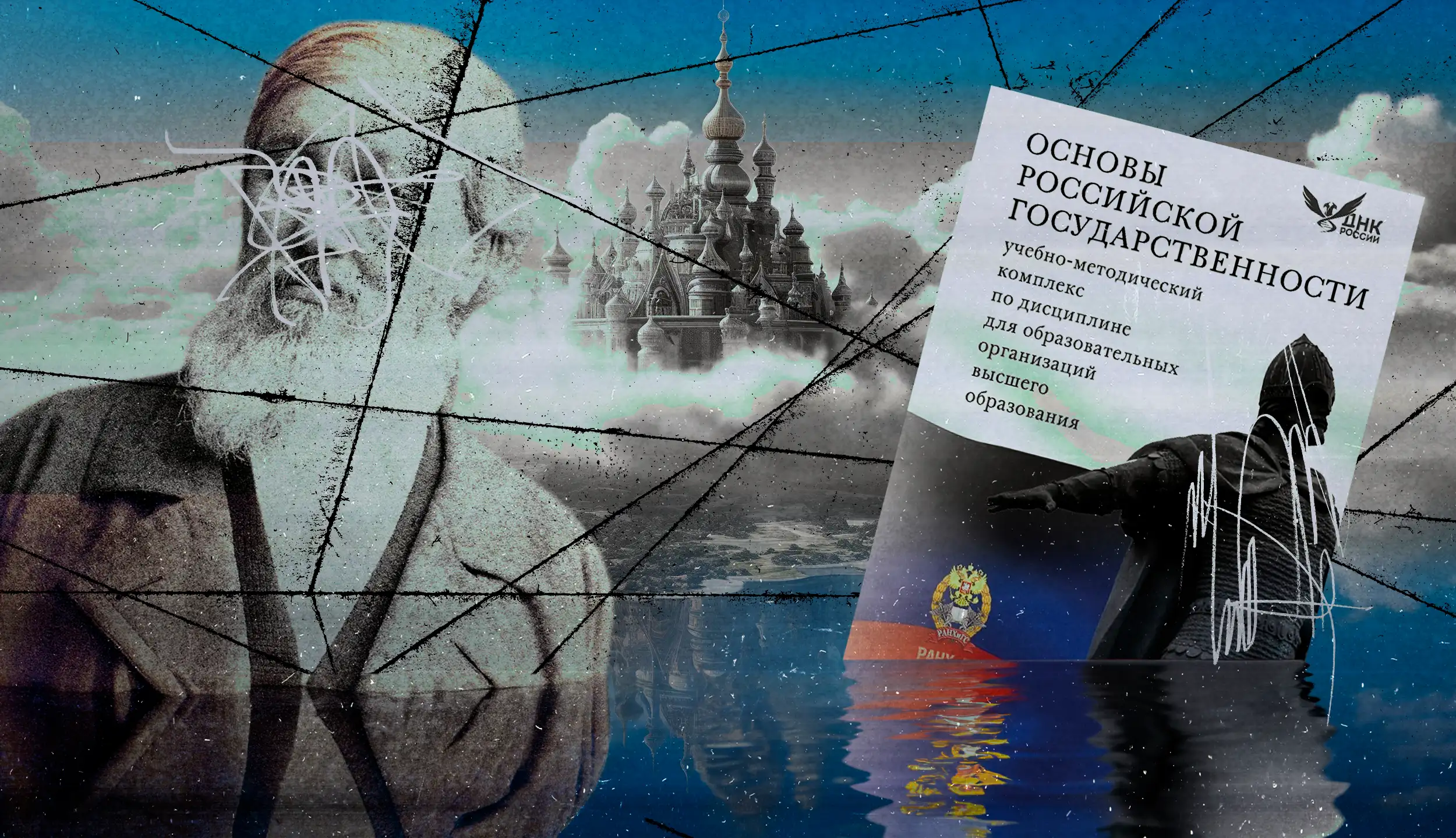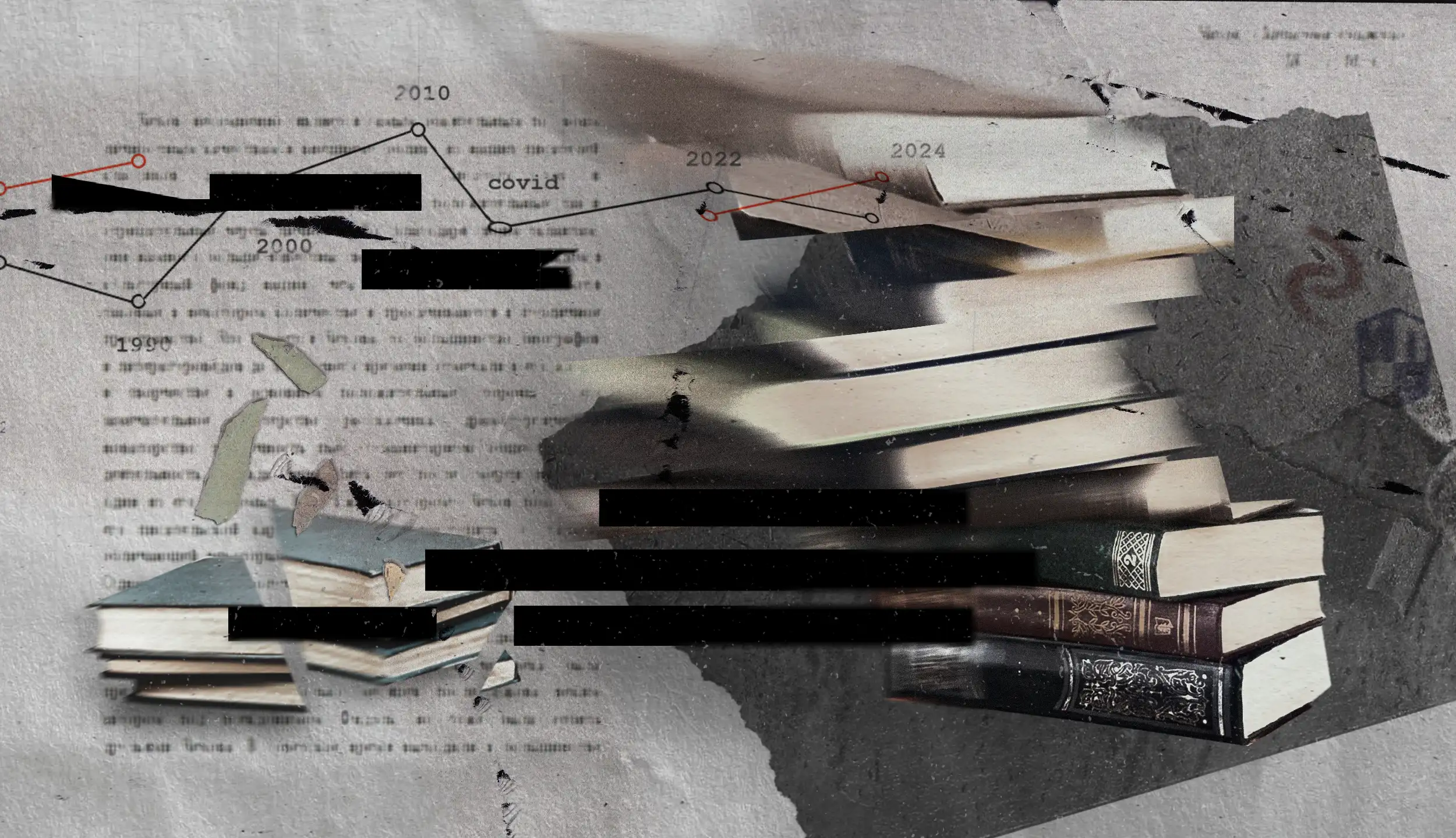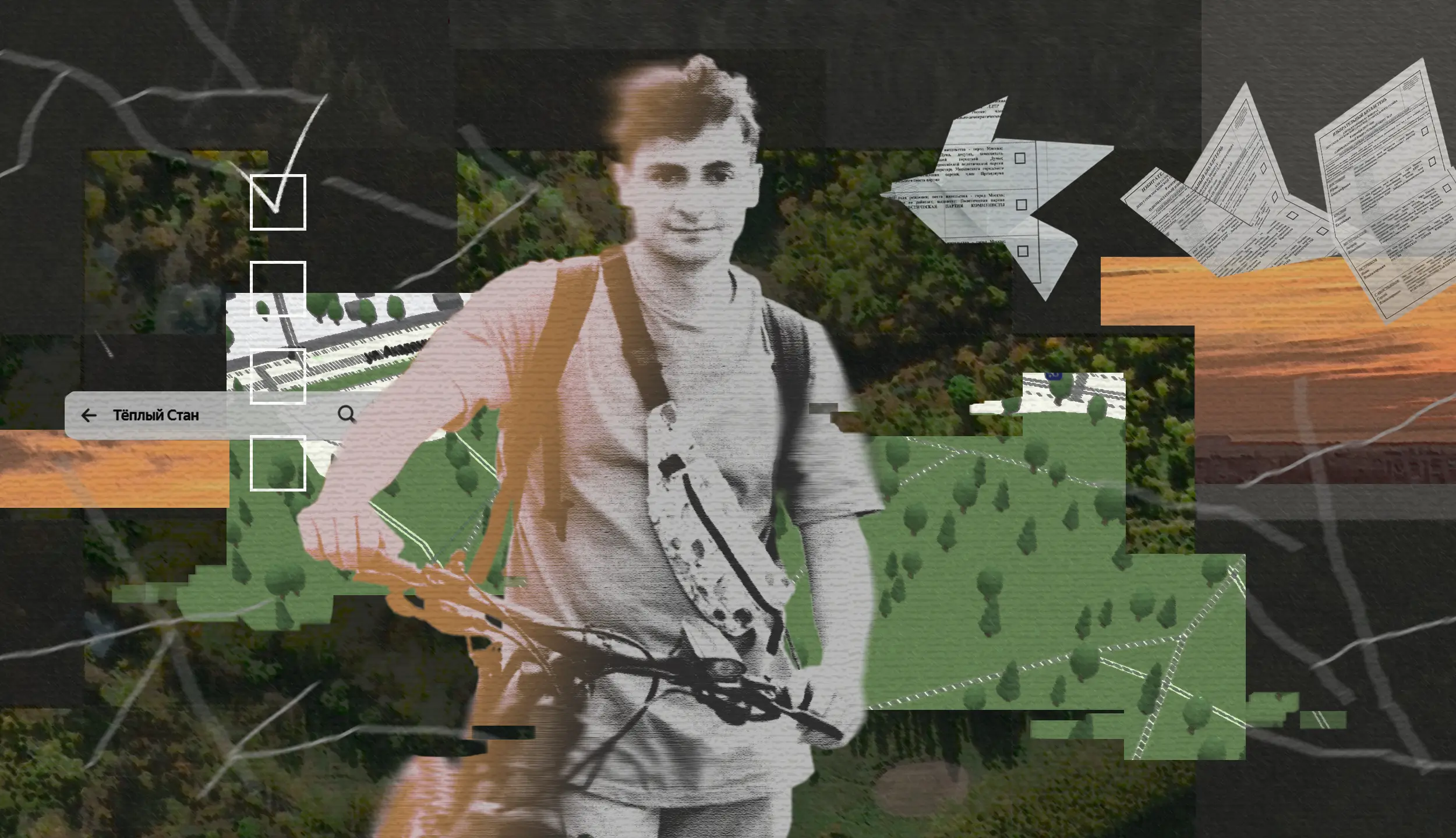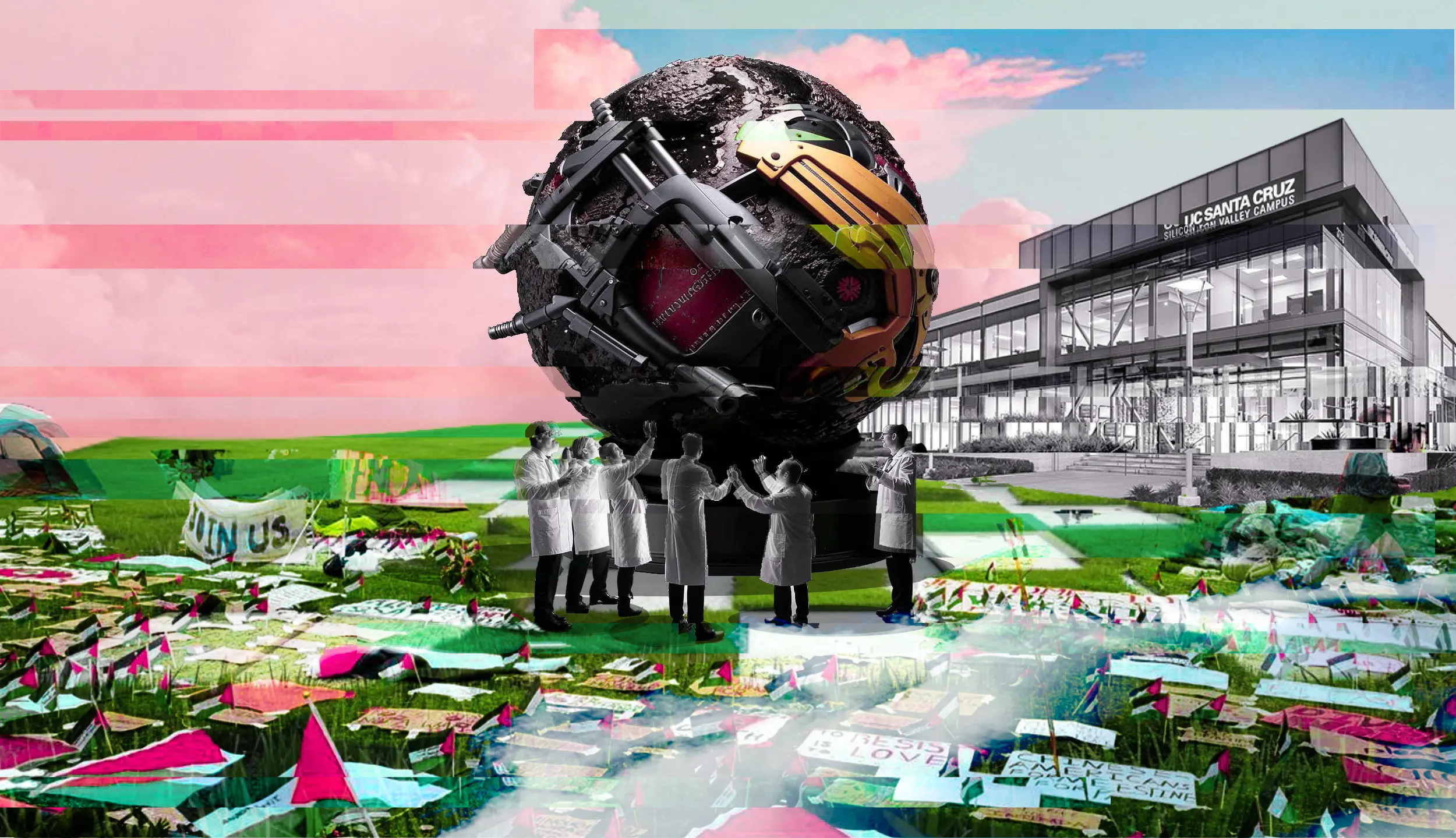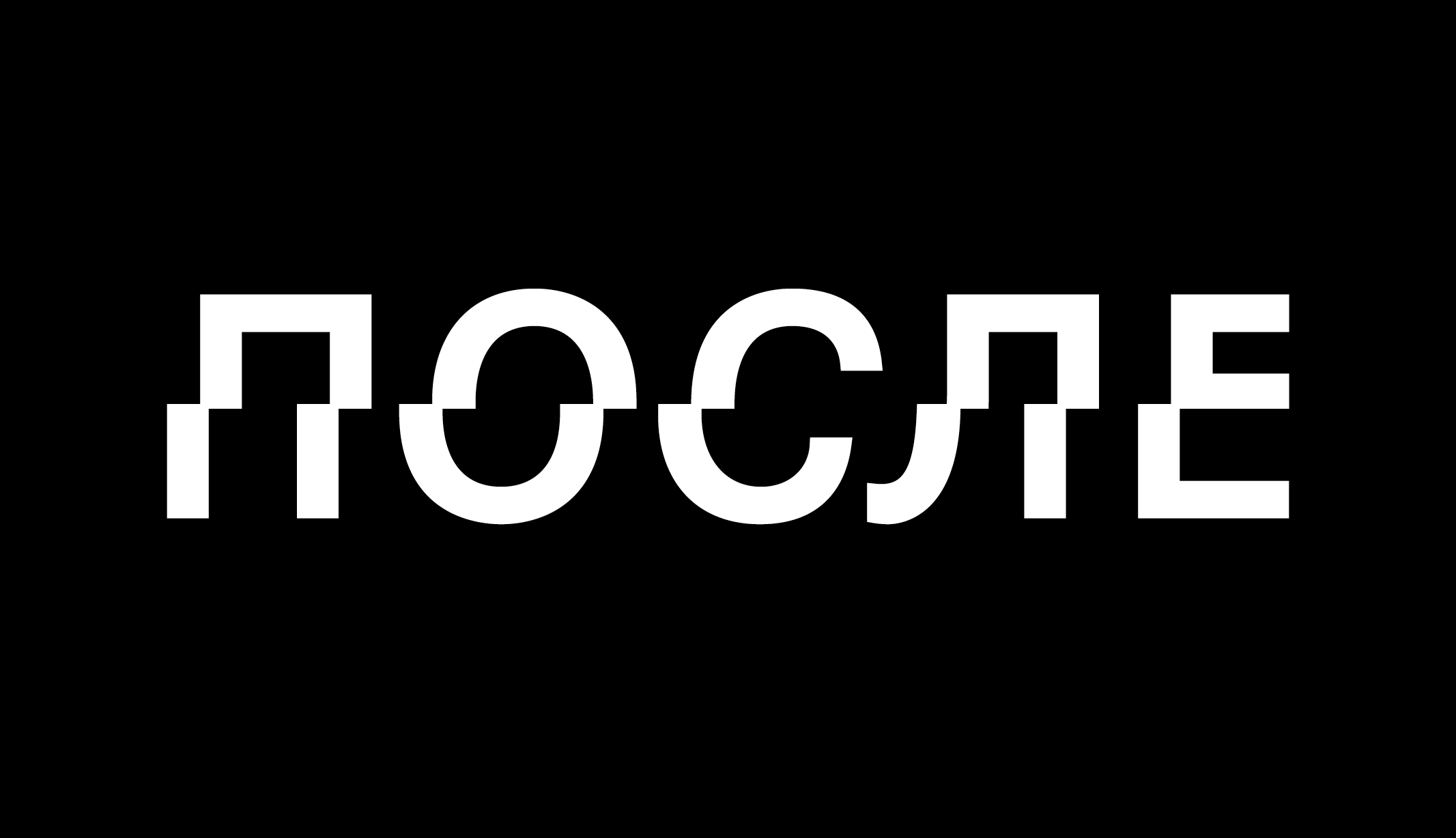“Our country, Russia, goes back more than a thousand years. This immense period greatly surpasses the extent of individual human life. Generations of our ancestors have accomplished to build an unparalleled and unique civilization — a society marked by grand achievements and the accomplishments of human genius.”
These are the opening lines of the textbook Fundamentals of Russian Statehood. Many students may have closed the textbook right there, at the beginning. It’s hard to blame them because it appears more like an excerpt from another Putin speech than a passage from an academic textbook. Nevertheless, we believe it deserves attention because it may aid in understanding the tools employed by Russian ideology and why it remains appealing to some individuals.
The media covering the release of the textbook mainly highlighted the crudest propagandistic clichés that found their way onto its pages, such as fanning an anti-immigrant moral panic over photographs of Muslims praying or denouncing veganism as a death cult. However, the textbook includes a recurring idea across topics and chapters and is already present in the introductory lines — the one of a distinct Russian civilization. This article will try to explain how the textbook’s authors from RANEPA (Russian Presidential Academy of the National Economy and Public Administration) employ the notion of “civilization” and the contradictions that this concept is intentionally concealing. Let’s have a closer look at it together.
Civilizations and nations
The theory of civilization assumes that there are several local civilizations in the world characterized by internal cohesion and destiny separate from others. This theory stands in opposition to the idea of a singular human civilization. In its origins, the theory of civilizations goes back to Nikolay Danilevsky, the Russian conservative philosopher, who called them “historical-cultural types.” Danilevsky contrasted Russia with the West, advocated for their fundamental discrepancy, and claimed a special messianic mission for Russian civilization. The authors of the textbook generally follow Danilevsky’s line of thought: initially recounting his ideas, they then transition to their own description of Russian civilization, diverging from the original source. They rather superficially and cursorily criticize theories of linear civilizational development, within which they include liberalism and Marxism, without making significant distinctions; they then focus on describing civilizational theory, specifically with regard to Russian civilization.
Civilizational theory has also found development in the West. The most renowned authors who have elaborated on it include Oswald Spengler, Arnold Toynbee, and Samuel Huntington. The authors who have used this concept theorize different numbers of local civilizations that have existed or continue to exist, and employ different criteria by which civilizations are defined. This brings us to one of the main problems of the civilizational theory, namely, it’s impossible to clearly define what a “civilization” is. The notorious ideological phrase might come in handy here: “East is East, and West is West…” Admittedly, the authors of the textbook seem to have limited interest in the definition of civilization, even less in civilizations other than the Russian one.
While trying to define Russian civilization, the authors come to a contradiction that vividly illustrates a problem within Russian ideology — the approach to ethnic issues. On the one hand, they consistently emphasize Russia’s multiethnicity as a civilizational feature and even as an advantage. On the other hand, they continually underscore the dominant role of the Russian people and sometimes go so far as to state that there is no difference between the terms “Russian ethnicity” and “Russian citizenship.”
Narrating the history of Russia, the conquests are constantly described with terms like “accession” and “accumulation of lands.”. However, at some point, they acknowledge the reality admitting that Russia did not always accumulate lands peacefully. Instances of resistance against Russian imperialism are cursorily listed: the Russian-Cheremis wars, conflicts with the Chukchi, uprisings of the Bashkirs and Kazakhs, uprisings in Poland, conquest of Central Asia, the Caucasian War. Yet, the authors swiftly provide justification stating the following: “Nevertheless, joining Russia often brought salvation. For instance, Russia effectively saved the Georgian people from disappearing.” In the picture painted in the textbook, the role of non-Russian-speaking peoples is to be loyal and grateful inferiors.
The idea of Russian civilization serves as a coverup for imperial policies. The Russian people, being the dominant agent within their own civilization, have the right to integrate other peoples into the country, to enrich Russia with their multicultural and multiconfessional contributions, emphasizing the distinctiveness of Russian civilization. The fact that the conquered peoples represent different cultures, speak different languages, and believe in a different God or gods is not seen as a hindrance by the authors. They deem Orthodoxy and the Russian language as pillars of Russian civilization. Presumably, the authors believe that not all cultures form civilizations, but only some, including the Russian. However, the difference between the cultures that create civilizations and those that do not is assumed by default rather than explicitly pronounced.
The conquered peoples are regarded as non-agents, as passive forces. The multinational and multiconfessional nature of Russian civilization, which people are encouraged to be proud of, appears as a mere list of different names that Russia has collected throughout its history. According to the textbook, the only people in history who had some kind of agency were the Cumans, who had been raiding Ancient Rus’ and were fairly punished. Any national liberation movements by other peoples are dismissed as foreign conspiracies. Apparently, they are seen as either other civilizations’ activities or some malevolent force that infiltrated Russian territory. The Bolshevik Party is the primary example of such detrimental influence.
Civilization serves as a framework for special peoples empowered to decide the fate of others. Russians appear not to be just one nation among many inhabiting Russia, as one might infer from the term “multinational people,” but rather a special nation, even something greater than just a nation. The authors of the textbook emphasize that the Russian people do not leverage special status for their own benefit. The Russian people are portrayed as long-suffering people, bearing the entire burden of Russian civilization on their shoulders, sacrificing themselves. The question of whether the conquered peoples desired such sacrifice for themselves, even if it occurred, is of no interest to the authors of the textbook.
There was no October Revolution
One major idea promoted in the textbook is the unity of the thousand-year-old Russian history and tradition developed during this time. Rus’, the Principality of Moscow, the Russian Empire, the USSR, and the Russian Federation are all different names for the same entity. It is particularly noteworthy how the history of the USSR and the October Revolution is covered in this regard. Mostly, the Soviet Union is considered yet another part of history that shares the same characteristics as other incarnations of Russia. Naturally, there are some rough edges. A major disconnection happened in 1917, after which Russia eventually recovered. Neither the reason for the disconnection, nor the essence of the October Revolution, nor the ideas of the rebels, are explained in the textbook.
At the same time, one learns that Lenin proclaimed independent Ukraine out of hatred for the Russian people. But this thesis is nothing new for Russian ideology. A certain novelty lies in the fact that, in this version of events, Lenin also invented great Russian chauvinism, for the struggle against which he supposedly committed his villainy. As for the subsequent years of the USSR, the textbook mentions it bore such important features of the Russian civilization as statism, the culture of servitude, and the idea of justice. It is noted that in the Soviet Union property was state-owned, which, according to the authors, had both its advantages and disadvantages. As for the shock therapy in the 1990s, it was a misguided and catastrophic policy. Fortunately, nowadays the right balance between public and private property finally has been achieved.
In other words, the history of the USSR was an incident in the history of Russia; despite some extremes, it was essentially the same Russia. The extremes have been eliminated and now there is not much to discuss. The way the causes of the October Revolution and the political ideas of the Bolsheviks are avoided in the textbook is not so much a symptom of the approach specifically attributed to Lenin and the Bolshevik Party but rather the history of the protest tradition in general. Issues of tradition seem to be crucial to the authors: basically, all ideas inherent to Russian civilization are reduced to one — living by tradition. Tradition is defined quite simply: “to live the way our ancestors had lived.” However, such a simple answer creates some problems. After all, the ancestors did not all live the same way — the ancestors rebelled, killed tzars, and got engaged in radical ideologies.
The authors acknowledge a tradition of popular sovereignty in the history of Russia in addition to the tradition of servitude. They pay relatively little attention to this tradition. In their opinion, it plays a supporting role in raising solidarity in society. One can observe a general trend running through the textbook: Russian civilization has always been unified internally and is in confrontation with other (mainly Western) civilizations. Violation of internal unity, accordingly, is always seen as a result of a consequence of external interference.
The way to achieve unity within a civilization is through historical policy. In the respective section, the authors inadvertently reveal the tasks assigned to them. They write that the purpose of historical memory is to create a consolidated view of historical events among citizens. This is achieved through state policies in culture and education, as well as through repression. The textbook does not reflect on the state’s role in these but tries to distinguish the correct historical policies and the incorrect ones (mainly pursued by Western countries). Correct historical policy is based on national memory, which supposedly contains a unified view of history and historical figures. For instance, Ivan the Terrible, they claim, is a positive character in popular memory, so all attempts to “denigrate” him are resisted by people.
The textbook, which is part of the state policy aiming to unify views on history, attempts to address the problem arising from its own definition of historical policy, that is the complete concoction of the historical narrative. It is appealing to a unified national memory as an objectively existing phenomenon. Needless to say, the attitude of any society toward its history cannot be unified, and Russia is no exception. The authors try to delude the reader with the idea that denying a unified state historical policy equals denying the national memory. Or, to put it quite bluntly, those who reject state propaganda go against the people. The logic of this move is justifying one construct, that is state ideology, with another, national memory, but presenting it as something that exists independently.
Indeed, national memory exists — in the sense that people living in Russia, naturally, have opinions on various historical episodes. But surely there cannot be unity on this matter (as seen even in pro-government sociological surveys). Nor is there any such thing for representatives of different ideologies or different nationalities. The conquest of Kazan is not viewed in the same way by Tatars and Russians, just as the history of the October Revolution is not assessed similarly by leftists and rightists. Class and national solidarity, which the authors are trying to pass off as a trait of Russian civilization, is wishful thinking.
Civilization and civilizations
Yet, the theory of civilization, despite its weak foundation and bias, has a certain appeal. It is not about what the theory asserts, but in what it denies. It is no secret that Putin, justifying his war against Ukraine, often declares that he represents countries dissatisfied with the unipolar global power of the United States. The theory of civilization is a convenient tool to provide an ideological basis for its distinctiveness from the West. It is popular not only in Russia, but also in India and, with reservations, even in China. Therefore, its supporters are not too concerned with the obvious difficulties in defining civilizations and identifying unification within. The question of whether, for example, the Mesoamerican civilization should be considered a separate civilization or not, is not of great concern to either the authors of the textbook or most supporters of this theory. What interests them is distinguishing themselves from the West and, more importantly, from universalism.
The textbook mentions several universalist concepts, that is, that there is one civilization and the laws applicable to some people should be applicable to others, and the world, in principle, can be measured by a common standard. The main trick here lies in reducing all universalist concepts into a unified whole, which is then equated with Western hegemony. The textbook is not very convincingly critical of “Western liberalism.” On the contrary, — propagandist clichés about omnipresent malign agents and abortion being a death cult are unlikely to convince anyone. But all this serves another purpose — reducing the world to a simple dichotomy: Western liberal universalism versus Russian “blooming complexity” (the latter is the term of Konstantin Leontiev, the Russian conservative philosopher and proponent of civilization theory). If the reader is not too pleased with the political system of the 21st century — there might be many reasons for this — the position presented by the authors may seem convincing. Even without agreeing with the deeply conservative and sometimes gloomy views of the authors, it is easy to understand why, in the dichotomy of Western hegemony and diversity, the latter may appear more appealing.
Therefore, merely exposing the historically illiterate and politically biased outbursts of the authors is not enough — doing so would only defend the established global status quo. The challenge lies deeper: —to break the monopoly on universality associated with the capitalist liberal order. By reducing all universalist concepts to it, the textbook simply reproduces the idea of the End of History often criticized by Russian propaganda. Francis Fukuyama’s idea has been criticized so much and for so long that it is probably difficult to find someone who would openly declare themselves its supporter. But it matters from which side the criticism comes. Samuel Huntington, whose name is associated with the revival of interest in civilization theory in the United States, wrote his article largely as a response to Fukuyama. He insisted that history had not ended; there are civilizational differences, therefore a clash of civilizations is inevitable, as is the conflict between the West and “Islamic civilization” specifically. This explanation of wars and conflicts assumes that certain ahistorical civilizational identities in the world are bound to clash permanently.
A materialistic explanation of conflict cannot be built on such an assumption. There are no inherent reasons why people should conflict — conflicts are the result of material conditions of existence. The leftist response to the conflicts caused by neoliberalism should not be to claim these are inevitable, as civilization theory asserts, but to put forward a different set of political demands. Global neoliberal capitalism should be opposed not by obscurantist essentialism, but by universalism of a different kind. Of all the substitutions that the authors of the textbook make, the most dangerous is their denying the possibility of any alternative.
The leftist movement, historically standing on the side of the oppressed, has always advocated not only the struggle for individual identities but for the construction of a world where no identity should be under threat. The contradiction presented by authors to the reader — between local “traditions” and the global force of liberalism — is false. Using civilizational identity, even if it seems completely undefined, the authors imitate the decolonial agenda, seeking to present Russia as an advocate for other civilizations opposing the global Western empire. Russian ideology performs a complex trick, presenting its own imperialism as a struggle against empires. While we share the idea of fighting against imperialism, this framing does not withstand criticism. Russian ideology calls to fight against one wrongdoer but fails to see the beam in its eye. The task should be to fight against the wrongdoing itself, of which contemporary Russia is an integral part.

